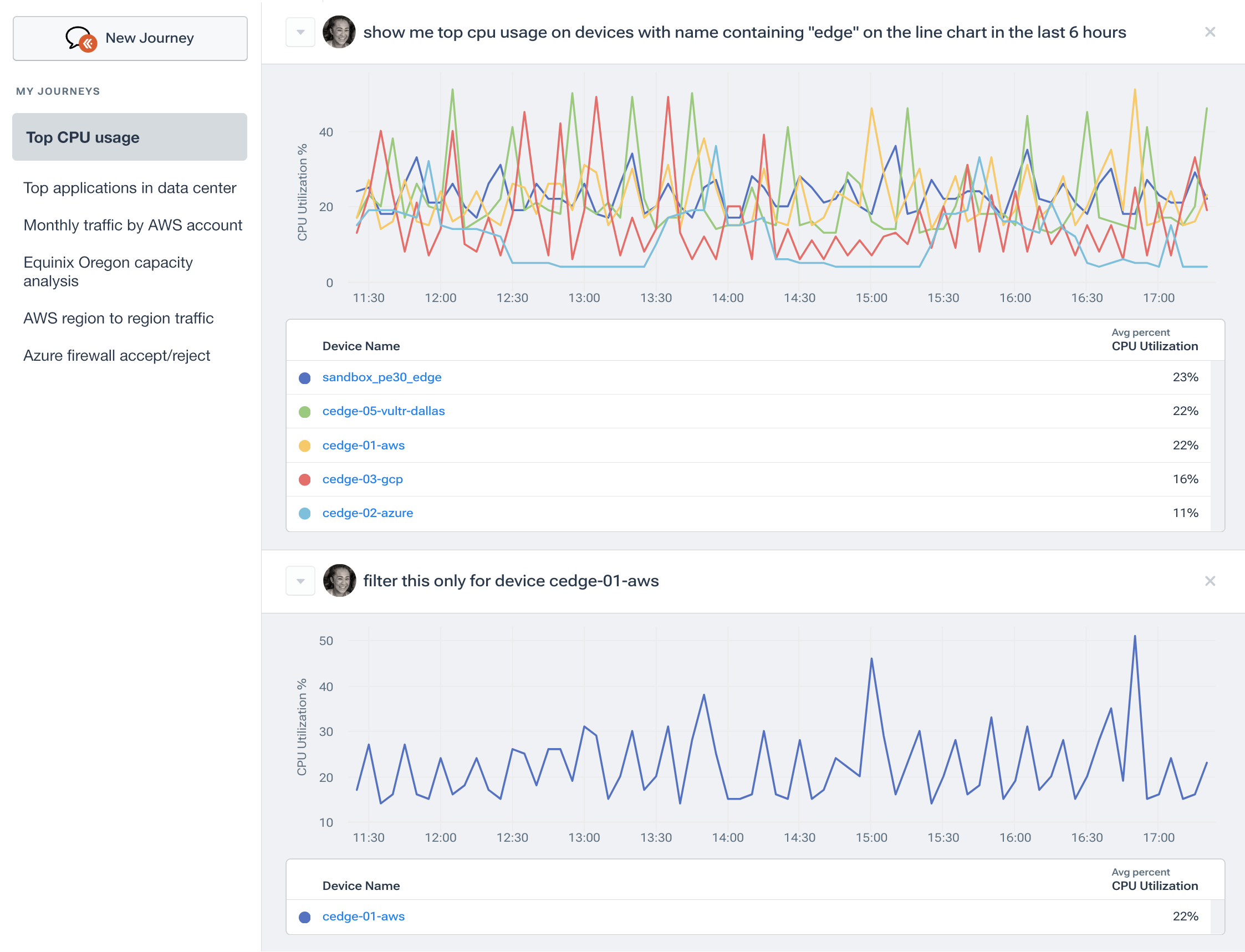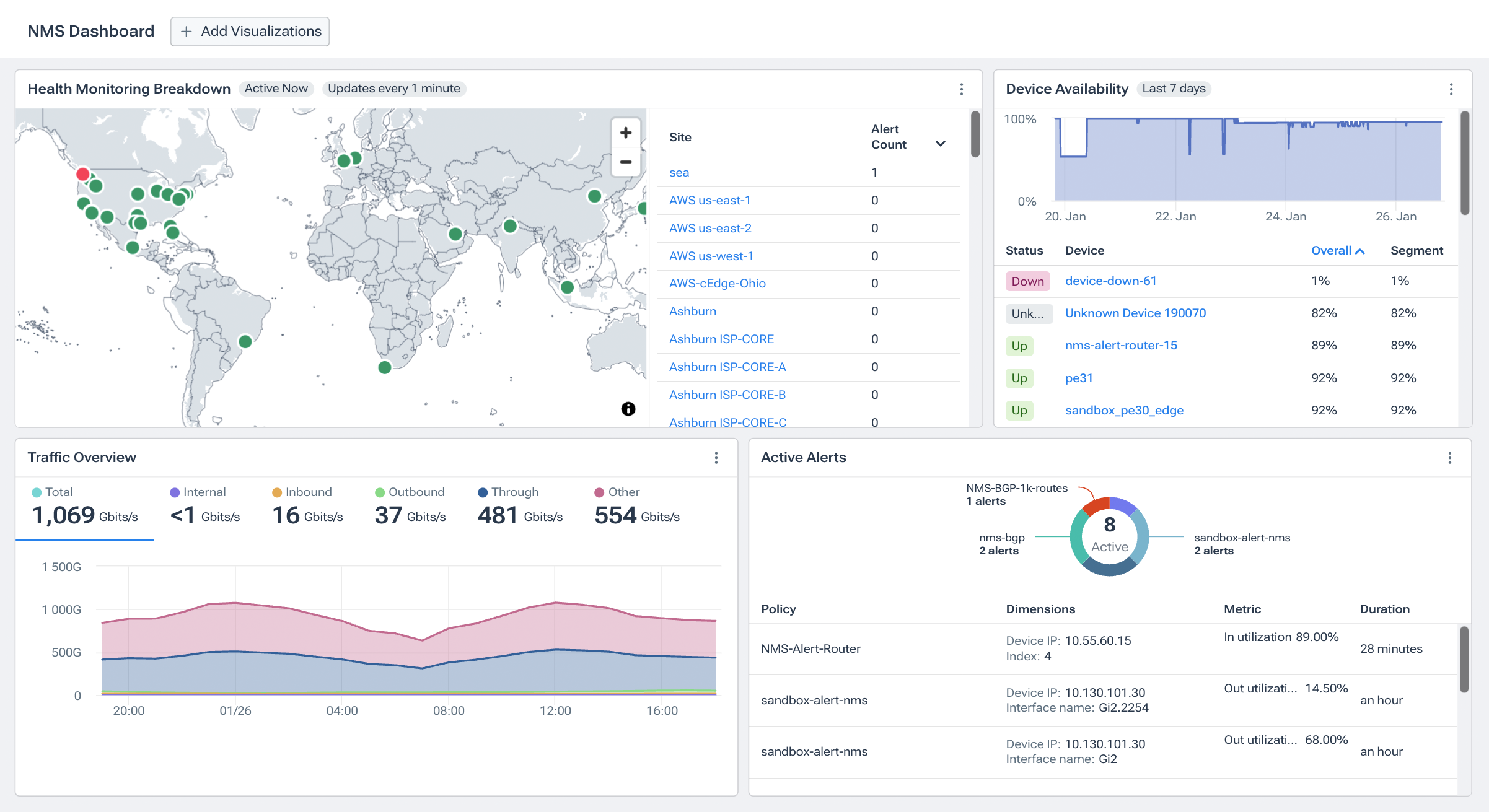Network Device Monitoring: Analyzing the Status, Health, and Performance of Network Devices
Network device monitoring is a crucial aspect of network management, ensuring optimal performance, availability, and security of various network devices such as routers, switches, firewalls, and servers. This article explores the intricacies of network device monitoring, discussing its importance, key performance metrics, diverse monitoring techniques, and best practices. We also compare network device monitoring (sometimes known as network status monitoring) to network performance monitoring (NPM).
What is Network Device Monitoring?
Network device monitoring is the process of continuously observing and analyzing the performance and status of network devices. This practice helps proactively identify potential issues, ensure optimal performance, and maintain a network’s overall health. The term “network device monitoring” often encompasses tracking key metrics and performance data related to device health, such as up or down status, availability, CPU utilization, memory usage, and disk space.
Network device monitoring can be carried out in several ways, each with unique advantages and use cases:
Active Monitoring
This approach periodically sends requests or pings to network devices to gauge their status and response time. Active monitoring can provide real-time or near-real-time data, making it helpful in identifying current network issues. However, it can also generate additional network traffic, which needs to be managed effectively.
Passive Monitoring
Passive monitoring involves analyzing network traffic that flows through the network devices. This approach can provide insights into network usage patterns, trends, and potential performance issues. However, it may not detect problems with devices that are currently not transmitting data.
Predictive Monitoring
Leveraging historical data and machine learning algorithms, predictive monitoring attempts to forecast potential issues before they occur. This proactive approach can help network administrators address problems before they affect network performance or lead to network downtime. However, it requires a significant amount of data and advanced analytics capabilities.
By combining these methods, network administrators can comprehensively understand their network’s health and performance. Regular monitoring helps to quickly identify and rectify issues, optimize resource usage, and plan for future capacity needs. As network technologies have evolved, network monitoring tools and strategies have become more advanced, offering capabilities such as automated alerts, trend analysis, and integration with other network management systems.
Why is Network Device Monitoring Important?
Network device monitoring is important as it ensures network devices’ optimal performance, availability, and security, which is vital for running network-based applications and services smoothly. In today’s environment, with cell phones always connected, cars connected, vending machines connected, and continuous inventory updates, we rarely run into people or devices that are not “connected” to the network. In addition, network device monitoring plays a crucial role in proactively identifying and resolving issues as they arise (network issues are a matter of “when,” not “if”), facilitating efficient management of network resources, and enhancing overall network security.
Network device monitoring equips administrators with detailed insights into the performance of individual devices throughout the entire network topology. As a result, administrators can promptly identify and mitigate any irregularities by continuously tracking key device health metrics. This proactive approach prevents minor issues from escalating into significant network disruptions, thereby maintaining service quality and availability. Moreover, administrators can optimize resource allocation, improve network efficiency, and reduce operational costs by monitoring network traffic patterns and device usage.
Key Metrics in Network Device Monitoring
Key metrics, often called device health metrics, play a crucial role in network device monitoring. Some of these important performance metrics include:
- Device availability: Measures the status of a network device. That is whether a device is online or offline (network device “up/down status”).
- CPU utilization: Monitors the percentage of CPU capacity that a device is currently using.
- Memory usage: Determines the amount of memory consumed by a device.
- Disk space: Evaluates the storage capacity used and available on a device.
- Device errors: Tracks the number and types of errors a device encounters.
- Uptime: Monitors the total time a device has been operational without interruption.

Network Device Monitoring Tools
Network device monitoring tools are software applications or SaaS platforms that continuously monitor network device performance. These tools collect data from various devices, analyze it to detect issues as they arise, and provide alerts to network administrators (including cloud administrators, site reliability engineers (SREs), NetOps, and DevOps teams). Selecting the right network device monitoring tool depends on various factors, such as the size of your network, the types of devices you need to monitor, the complexity of your network infrastructure, and your specific monitoring needs.

Types of Devices Monitored by Network Device Monitoring Tools
Network device monitoring tools can be used to manage a wide range of devices. Whether the devices are physical or virtual, on-premise or in the cloud, monitoring tools provide crucial insights into their performance and status. Examples of network devices that are commonly monitored include:
- Routers: These devices forward data packets between computer networks. Monitoring routers can help detect packet loss, latency, or unusually high traffic.
- Switches: Switches channel incoming data from multiple input ports to the specific output port that will take the data toward its intended destination. Monitoring switches can help ensure efficient data routing and identify bottlenecks.
- Firewalls: Firewalls control incoming and outgoing network traffic based on predetermined security rules. Monitoring firewalls can help ensure security protocols are being adhered to and alert administrators to potential security breaches.
- Servers: Servers provide services across a network. They can be physical or virtual and host applications, databases, file services, etc. Server monitoring can help ensure the availability and performance of these critical devices.
- Wireless Devices: This includes wireless routers, access points, and other devices facilitating wireless connectivity. Monitoring these devices can help maintain the quality of wireless connections and detect RF (radio frequency) issues.
- Virtual Machines (VMs): VMs are software emulations of physical computers. They run an operating system and applications just like a physical computer. Monitoring VMs is critical for maintaining the performance of virtualized environments.
- Cloud Devices: These can include various virtual devices hosted in the cloud, such as Virtual Private Networks (VPNs), Virtual Private Clouds (VPCs), transit gateways, cloud firewalls, and load balancers. Cloud device monitoring provides visibility into the performance of these devices, which is crucial for maintaining the health of cloud-based environments.
- Containers: Containers are standalone, executable packages of software that include everything needed to run a piece of software, including the code, runtime, system tools, system libraries, and settings. Container monitoring is essential in modern cloud-native environments to ensure the performance and availability of containerized applications.
- IoT Devices: The Internet of Things (IoT) is a network of physical objects (“things”) embedded with sensors, software, and other technologies to connect and exchange data with other devices and systems over the internet. Monitoring IoT devices can help ensure these devices function properly and securely.
Each type of network device can present unique monitoring challenges, but with the right tools, network administrators can maintain comprehensive visibility into their performance and status. Monitoring a combination of these devices, especially in hybrid environments that mix on-premise and cloud-based devices, is essential for maintaining a healthy and efficient network.
Kentik’s network device monitoring tool (Kentik NMS) supports nearly any type of network device, via SNMP or streaming network telemetry where supported. The solution supports popular routers, switches, firewalls and other types of interfaces from network device manufacturers including A10, Accedian, Adva, Alteon, APC, Arista, Avocent, CloudGenix, Cisco, F5, Fortinet, Gigamon, Infoblox, Juniper Networks, Lantronix, Mikrotik, pf_sense, Ubiquiti and more. And Kentik provides powerful hybrid and multicloud monitoring and visibility capabilities for cloud and container-based network devices.
The definitive guide to running a healthy, secure, high-performance network

Network Device Monitoring Techniques and Protocols
There are several techniques and protocols employed in network device monitoring, each providing a different perspective on the status and health of network devices.
Simple Network Management Protocol (SNMP)
SNMP is an IETF standard protocol for collecting and organizing information about managed devices on IP networks. SNMP operates in a client-server model where network devices act as servers, and the monitoring system acts as a client. SNMP collects information related to the status, configuration, and performance of devices, which is then stored in a management information base (MIB) and can be queried by network administrators.
Implemented nearly universally in every network-connected device, SNMP can be used to track a wide variety of network device health and performance metrics beyond whether the device is available (its “up/down status”), including:
-
Core Network Device Metrics: Metrics uch as CPU utilization, memory utilization, disk or other storage usage, bandwidth utilization, and uptime (the duration for which the device has been operational without interruption).
-
Network Error Metrics: Metrics that indicate potential issues within network devices including dropped packets and packet Loss rate which measure data transmission quality and network efficiency.
-
Hardware Device-Specific Metrics: Metrics that reflect the physical aspects of network hardware, including temperature and various hardware fan speeds, which are essential for maintaining optimal operating conditions.
-
Non-Routable Interface Status: This metric refers to network interfaces that are not designed for routing traffic but are essential for local network management. Monitoring these interfaces is vital for:
- Ensuring the proper configuration and functioning of local management ports that may not participate in data routing but are crucial for device maintenance and management.
- Detecting issues with local connectivity or administrative access points, which might impact network management or security.
Streaming Telemetry
Streaming telemetry is considered the next evolutionary step from SNMP in network device monitoring data collection. It differs from SNMP in how it works, if not in the information it provides. Streaming telemetry solves some of the problems inherent in the polling-based approach of SNMP.
The various forms of streaming telemetry, such as gNMI, structured data approaches (like YANG), and other proprietary methods, offer near-real-time data about the status of network devices. Instead of waiting minutes for the subsequent polling to occur, network administrators get information about their devices in near real-time.
Because data is pushed in real-time from the devices and not polled at prescribed intervals, streaming telemetry provides far higher-resolution data compared to SNMP. This push-based model is generally more efficient than SNMP. Streaming telemetry processing often happens in hardware at the ASIC itself instead of on the device’s CPU. As a result, it can scale in more extensive networks without affecting the performance of individual network devices. (See our blog post for a more in-depth look at streaming telemetry vs SNMP.)
Syslog and Log Files
These files contain messages about the device’s activities, including operational status, error messages, and other event data. Syslog is a standard protocol for sending log messages from devices to a central log server. These logs are crucial for troubleshooting, monitoring device performance, and maintaining security. They can also provide valuable insights during forensic investigations.
NetFlow Monitoring
NetFlow is a protocol developed by Cisco for collecting IP traffic information and monitoring network traffic flow. NetFlow captures metadata about network data packets (such as source IP, destination IP, ports, and protocol) and aggregates it into flows, providing visibility into traffic patterns and trends. Numerous variations on NetFlow from different vendors, such as sFlow (from InMon) and Jflow (from Juniper Networks), offer similar functionality.
Cloud-based Device Monitoring
This refers to monitoring techniques specifically designed for cloud devices (e.g., VPNs, VPCs, transit gateways, cloud firewalls, load balancers, etc.) hosted in cloud environments. Given the distributed and dynamic nature of the cloud, traditional network monitoring solutions and techniques may only sometimes suffice. Cloud devices often support NetFlow-like traffic telemetry in the form of VPC Flow Logs, providing visibility into IP traffic going to and from network interfaces in a Virtual Private Cloud (VPC).

Service Mesh
Originally developed by Lyft as Envoy, Istio is a framework for network traffic management. Istio is an extension of Envoy that adds policy enforcement and telemetry collection. While not a monitoring protocol per se, Istio offers key functionalities that aid in monitoring applications deployed in a distributed microservices architecture, as commonly found in hybrid and multi-cloud environments. It gives detailed insights into service behavior, enabling efficient troubleshooting, performance tuning, and security monitoring.
Each of these protocols and techniques offers a different set of capabilities, and the choice of which to use often depends on the specific requirements of the network environment. These techniques are often combined to achieve comprehensive network device monitoring.
Benefits of Network Device Monitoring
Network device monitoring offers several benefits:
- Proactive problem solving: Network administrators can detect potential issues early and address them before they escalate by continuously monitoring device performance.
- Better management and control: Network device monitoring provides insights into device performance and usage, enabling better resource management and control.
- Improved network efficiency: Network device monitoring can help improve network efficiency by identifying bottlenecks and other issues.
- Enhanced security: Monitoring devices can help detect unusual activity that could indicate a security breach.
Setting Up Network Device Monitoring
Setting up effective network device monitoring is fundamental to adopting a proactive and responsive approach to network management. Initial steps and considerations to ensure comprehensive and actionable device monitoring include:
Defining Monitoring Objectives and Metrics
Identifying the right key performance indicators (KPIs) is crucial for targeted monitoring. By defining these KPIs, administrators can establish meaningful thresholds and set up alerts for critical events, ensuring prompt detection and response to potential issues.
Monitoring Device Health and Configuration
For effective monitoring, it’s vital to configure network devices for protocols like SNMP, streaming telemetry or flow data collection. Additionally, routinely updating device firmware and software ensures that monitoring tools can access the most accurate and comprehensive device metrics without compatibility issues.
Data Visualization and Reporting
Visualizing monitoring data through intuitive dashboards and graphs can give a clearer view of network performance and trends. Periodic reports generated from this data further facilitate detailed analysis. Ongoing visualization and reporting can help network administrators make informed decisions and optimize network health.
Network Device Monitoring vs. Network Performance Monitoring
While the terms Network Device Monitoring (NDM) and Network Performance Monitoring (NPM) may seem synonymous, they each represent distinct but complementary aspects of network management. Both are essential for maintaining a healthy and efficient network but focus on different elements and serve unique purposes.
Focus of Network Device Monitoring
Network Device Monitoring (NDM) primarily focuses on the health and status of individual devices within the network. It involves tracking key metrics such as device availability, CPU usage, memory usage, disk space, device errors, and uptime. NDM aims to ensure that each device functions properly and identifies potential issues before they escalate.
NDM involves monitoring a wide range of devices, including routers, switches, servers, firewalls, VMs, and various cloud and IoT devices. It can help detect hardware failures, software crashes, overloaded resources, and other device-specific issues. By providing real-time or near-real-time information about each device, NDM enables network administrators to maintain the network’s overall health.
Focus of Network Performance Monitoring
Network Performance Monitoring (NPM), on the other hand, focuses on the performance and quality of service of the network as a whole. It involves measuring, diagnosing, and optimizing the service quality of network traffic. Key metrics in NPM include network latency, packet loss, jitter, and bandwidth usage.
NPM tools often provide features such as traffic analysis, capacity planning, network mapping, and Quality of Service (QoS) analysis. They can help identify network bottlenecks, bandwidth hogs, and performance issues related to network traffic. NPM helps ensure optimal service delivery and user experience by providing insights into how network traffic impacts the network’s performance.
Complementary Roles of NDM and NPM
While NDM and NPM focus on different areas, they are closely related and often used together for comprehensive network management. For example, a device failure detected by NDM could explain a performance issue identified by NPM. Conversely, a network performance issue might lead administrators to check the health of individual devices.
While Network Device Monitoring is concerned with the health and functionality of individual devices within a network, Network Performance Monitoring is centered around the operational efficiency and service quality of the network as a whole. A robust network management strategy typically involves both NDM and NPM, providing network administrators with a holistic view of their network’s health and performance.
For example, Kentik’s network intelligence platform integrates both network device monitoring and network performance monitoring features, enabling comprehensive network visibility and control. This integrated approach ensures that any potential device-specific or network-wide issues can be quickly identified and resolved, maintaining optimal network performance and availability.
Challenges in Network Device Monitoring
Despite its benefits, network device monitoring is not without its challenges:
- Network complexity: Modern networks can be incredibly complex, making monitoring a challenging task.
- Device heterogeneity: Networks often consist of a wide variety of devices from different manufacturers, each with its own set of protocols and metrics, which can complicate monitoring efforts.
- Scale of monitoring: As networks grow in size and complexity, so does the task of monitoring, increasing the risk of oversight and missed issues.
- Cloud-based environments: While cloud-based networks offer numerous benefits, they also present unique challenges for network monitoring solutions, including issues of visibility and control.
Modern network observability solutions such as Kentik address a wide array of network monitoring use cases and technologies. While Kentik NMS (Network Monitoring System) performs all the functions of traditional network infrastructure device monitoring tools, Kentik also offers flow-based network traffic analysis, synthetic monitoring and testing, cloud/container network monitoring, and much more.
Network Device Monitoring Best Practices
To effectively monitor network devices, consider the following best practices:
- Regular device monitoring: Monitor your devices to catch potential problems before they escalate.
- Utilize multiple monitoring techniques: Different techniques can provide different insights, so combining methods is often the best approach.
- Establishing baselines: You can more easily identify when something is wrong by establishing normal performance baselines.
- Proactive alerting: Set up alerts to be notified immediately when a potential issue arises.
- Continual optimization and review: Regularly review your monitoring practices and make adjustments to ensure they remain effective.
Network Segmentation and Isolation
Segmenting the network simplifies monitoring and expedites troubleshooting by categorizing devices into manageable groups. Isolating critical devices enhances security, limiting exposure to potential threats and ensuring dedicated performance monitoring for crucial network components.
Redundancy and Failover Planning
Implementing device redundancy ensures continuous monitoring, even when a primary device encounters issues. Failover plans are essential for uninterrupted network monitoring, as they provide automatic switching to a backup system, preventing potential outages and ensuring consistent network observability.
Network Device Monitoring with Kentik’s Next-Generation Network Monitoring System
Kentik’s network observability solution facilitates an in-depth understanding of both overall network performance as well as individual network device health. It enables proactive monitoring of all critical network device metrics, providing NetOps professionals with essential insights for maintaining network health and efficiency.
Kentik offers a suite of advanced network monitoring solutions designed for today’s complex, multicloud network environments. The Kentik Network Intelligence Platform empowers NetOps pros to monitor, run and troubleshoot all of their networks, from on-premises to the cloud.
Kentik isn’t just a network device monitoring solution. Its SaaS network intelligence platform delivers visibility into network flow, powerful synthetic monitoring capabilities, and Kentik NMS, a next-generation network device monitoring solution.
To learn how Kentik can bring the benefits of network intelligence and observability to your organization, request a demo or sign up for a free trial today.


